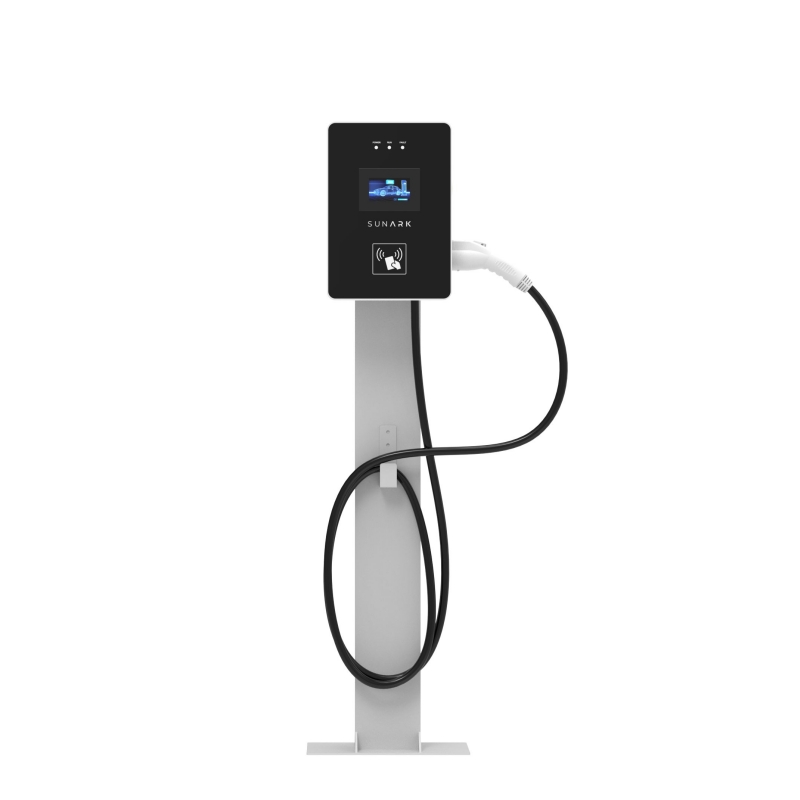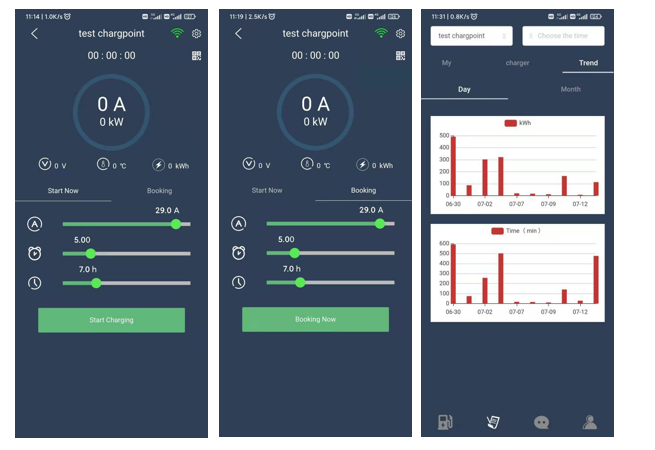A fast charging AC electric vehicle (EV) charger, also known as Level 2 charger, is a type of charger that provides higher charging power compared to standard home chargers. Level 2 chargers typically use a 240-volt power source, which allows for faster charging times compared to standard 120-volt outlets.
Standard:
SAE Standard / IEC StandardConnector type:
Type 1 / Type 2Connector Mechanical Operating Life:
≥10000 times
Here are some key features and benefits of fast charging AC EV chargers:
Faster charging times: Fast AC chargers can deliver charging power ranging from 3.3 kilowatts (kW) to 19.2 kW or higher, depending on the charger's capacity and the vehicle's onboard charging capabilities. Charging times can be significantly reduced compared to standard home chargers, allowing you to charge your EV more quickly.
Versatility: Fast AC chargers are compatible with a wide range of electric vehicles as they adhere to the SAE J1772 standard, which is widely adopted in North America, and the IEC 62196 Type 2 standard, which is commonly used in European countries. This means that most electric vehicles can be charged using a fast AC charger.
Convenience: Fast AC chargers are often installed in public charging stations, workplaces, and other locations where EV owners can quickly charge their vehicles while running errands or during working hours. Many fast AC chargers also come with features such as smart charging, mobile apps, and payment systems to enhance user convenience and accessibility.
Home installation options: While fast AC chargers are commonly found in public locations, they can also be installed in residential settings. This allows EV owners to have a fast charging solution at home, providing the convenience of quicker charging times and reduced reliance on public charging infrastructure.
Cost-effective: Compared to DC fast chargers, which are more expensive and require significant power infrastructure, fast AC chargers are generally more affordable. Therefore, they are a popular choice for residential and commercial installations, offering a balance between charging speed and cost.
It's important to note that fast AC chargers are not as fast as DC fast chargers, which can deliver much higher charging power. However, for everyday charging needs and moderate-range electric vehicles, fast AC chargers can provide a practical and efficient charging solution.

What main advantages of AC EV chargers have?
Compatibility: AC chargers are compatible with almost all electric vehicles on the market because they use the same AC power supply as residential and commercial buildings.
Cost-effective: AC chargers are generally less expensive to install compared to DC chargers.
Flexibility: AC chargers offer flexibility in terms of charging power. They can be installed with different power levels, ranging from 3.7 kW to 22 kW or even higher, depending on the specific charging station.
Slow-charging option: AC chargers are commonly used for slow charging, which is suitable for overnight charging at home or long-duration charging at workplaces.
Widely deployed: AC charging infrastructure is more widely available and established than DC charging infrastructure.

How does a typical DC charging station works?
Connection: The EV driver connects their vehicle to the charging station using a DC charging cable. These cables are usually equipped with standardized connectors such as CHAdeMO, CCS (Combined Charging System), or Tesla Supercharger connector, depending on the charging network and the EV's compatibility.
Power Conversion: The charging station contains power electronics that convert the incoming AC power from the electrical grid to DC power.
Communication: The charging station communicates with the EV to establish a connection and exchange necessary information.
Charging Protocol: The charger and the EV communicate to determine the appropriate charging protocol. The charging protocols, such as CHAdeMO or CCS, define the communication standards and charging methods used during the charging process.
Charging Process: Once the charger and the EV establish a connection and agree on the charging protocol, the actual charging process begins. The charger supplies DC power to the EV's battery, bypassing the onboard charger present in the vehicle.
Safety and Monitoring: The charging station continuously monitors the charging process to ensure safety and protect the battery from overcharging or overheating.
Charging Completion: Once the EV's battery reaches a sufficient charge level or the charging session is manually stopped, the charger ceases the flow of power.

What charging protocols do EV chargers have?
Electric Vehicle (EV) chargers typically support different charging protocols or standards. The most common charging protocols for EVs are:
CHAdeMO: Developed by the CHAdeMO Association, this protocol is primarily used by Japanese automakers such as Nissan and Mitsubishi. It supports both DC fast charging and AC charging.
CCS (Combined Charging System): The CCS protocol is a combination of the existing AC charging standard (Type 2 or J1772) and DC fast charging. It is the most widely adopted standard globally and is supported by most European and American automakers.
CCS Type 1: Used predominantly in North America, it utilizes the SAE J1772 connector for AC charging and adds additional pins for DC fast charging.
CCS Type 2: Used primarily in Europe, it employs the IEC 62196 (Type 2) connector for AC charging and integrates extra pins for DC fast charging.
Tesla Supercharger: This is a proprietary charging protocol developed by Tesla for their vehicles. Tesla Superchargers use a unique connector that is only compatible with Tesla vehicles. However, Tesla has also started to include CCS connectors in their newer models, allowing them to use non-Tesla DC fast chargers.
It's worth noting that some modern EV chargers support multiple charging protocols, allowing them to charge a wide range of electric vehicles. These chargers are often referred to as "multi-standard" or "universal" chargers.
FAQs:
Q1: Do you support OEM/ODM?
A:Definitely, OEM&ODM service is supported with a certain quantity,including customize logo,package and label;
Q2: What's the production time?
A: The production time is normally 15 working days. but we will always prepare some stocks for popular models.
Q3: Can you provide DDP service?
A:Yes, if you are a personal customer and don't want to deal with the customs, we can provide DDP service to your address.
Q4: What about the warranty and how to claim?
A: Warranty period are 5 years since you receive the product, our professional after-sales team will deal with all warranty issues.